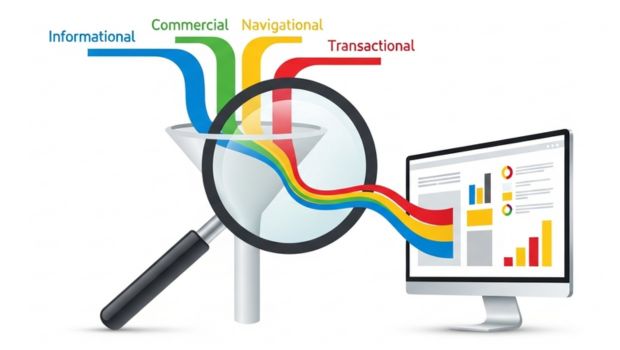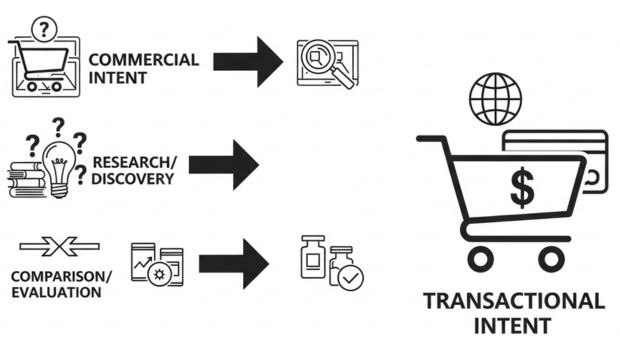Search Intent in SEO: Types, Keywords & Optimization Examples (Complete Guide)

Search intent, also known as user or keyword intent, refers to the main goal or purpose a user has when entering a query in a search engine. Understanding search intent is fundamental for effective SEO, as it directly influences how content should be structured and optimized to match what users are really searching for.
What Is Search Intent?
Search intent is the intention behind a user's search query, such as seeking information, making a purchase, finding a specific website, or comparing products. Matching content to search intent helps sites provide relevant solutions, increasing their chances of ranking highly in search results.What Each Intent Means
- Informational: Users want to learn, understand, or explore a topic.
- Navigational: Users seek a specific brand, website, portal, or page.
- Transactional: Users are ready to take action (buy, book, request a quote).
- Commercial: Users compare options before purchase (reviews, features, vs.).
How to Detect Mixed Intent
Not all search queries fit neatly into a single intent. Often, users express mixed intent through blended keywords that signal more than one purpose. For example, a term like “best price” indicates both commercial and transactional intent, while a query such as “Brand how to” combines navigational and informational purposes. Similarly, “Compare X vs. Y buy” blends commercial comparison with a transactional goal.
To identify mixed intent, it is useful to analyze SERP features—if both guides and store listings appear together, it’s a strong sign that multiple user needs are being served in a single query. Recognizing mixed intent helps craft content that not only answers the immediate question but also guides the visitor toward the next logical step in their journey.
Search Intent & Dominant Keywords
| Search Intent | Dominant Words / Frequent Keywords |
|---|---|
| Informational | who, what, when, where, why, how, tutorial, guide, tips, examples, definition, benefits, easy, learn, explain, best |
| Navigational | brand names, specific website names, login, homepage, official, site, portal, account, customer service, location names |
| Transactional | buy, purchase, order, discount, coupon, deal, free shipping, price, sale, order now, shipping, request a quote, book |
| Commercial | best, top, reviews, compare, versus (vs.), affordable, cheap, price, alternatives, pros and cons, features, recommendations |

Essential Keyword Triggers for Every Type of Search Intent
- Provide common trigger words for informational intent
- who, what, when, where, why, how
- tutorial, guide, tips, examples
- definition, benefits, learn, explain
- List commercial-intent keywords to include in content
- best, top, reviews, compare, vs.
- affordable, cheap, price, alternatives
- pros and cons, features, recommendations
- Give transactional intent words used by buyers
- buy, purchase, order, price, sale
- discount, coupon, deal, free shipping
- order now, shipping, request a quote, book
- Show navigational intent words and examples
- brand names, official, homepage, login, portal
- account, customer service, site, location names
- Example: “Nike official site login”
The Intent Flow Strategy

Intent flow strategy is much more than a mere optimization technique; it is a holistic philosophy that focuses on guiding visitors naturally through stages of their journey. True optimization does not stop at matching the initial search intent—its purpose is to anticipate and nurture the next logical step in the user’s experience. By linking every process, from awareness to action, intent flow ensures visitors find relevant answers, feel supported, and are offered the opportunity to deepen their engagement.
This seamless transition is crucial: optimization means actively encouraging the visitor’s progression, not just providing a one-time solution. When content and site architecture are designed for continuous movement along the intent flow, engagement, satisfaction, and conversion all increase substantially.
Importance of Search Intent in SEO
Search engines like Google prioritize serving results that best match the user's intent, not just those that include the searched keywords. Google’s algorithms use semantic search to understand query context and intent. Pages that don’t satisfy search intent are unlikely to rank, regardless of backlinks or other traditional SEO factors.How to Optimize for Search Intent
- Analyze top-ranking pages for the target query to determine the dominant intent.
- Align your content structure and purpose with that intent, whether it’s a detailed guide, product page, listicle, or landing page.
- Regularly update content to ensure continued alignment as search engine algorithms and user behaviors shift.
Practical Example: Map Search Intent to Content (Step-by-Step)
- Scenario: You run an ecommerce store selling running shoes and want to capture demand across the funnel.
- Goal: Match pages to intent so users always land on the most helpful resource.
| Sample Query | Detected Intent | Why (Signals) | Best Page Type | Primary CTA |
|---|---|---|---|---|
| what are running shoes | Informational | “what”, definition-style query | Educational guide with glossary & illustrations | Subscribe for tips |
| best running shoes for flat feet | Commercial | “best”, “for” + condition (comparison intent) | Expert comparison list, pros/cons, fit advice | View product shortlist |
| nike pegasus 41 | Navigational | Brand/model name | Brand/model hub page with specs & FAQs | Go to product page |
| buy running shoes online | Transactional | “buy”, action language | Category PLP with filters, stock, price | Add to cart / Checkout |
How to Implement This on Your Site
- Match format: Use guides for informational, comparisons for commercial, brand hubs for navigational, and product/category pages for transactional.
- Tune on-page cues: Headlines, intro, and CTAs should reflect the detected intent (e.g., “Compare” vs. “Buy Now”).
- Bridge paths: Add internal links from informational guides → comparison lists → category → product → checkout.
- Measure success: Track time on page & scroll (info), CTR to product (commercial), add-to-cart (transactional), and branded clicks (navigational).
Practical Example: Matching Intent for "Python for Beginners"
- Scenario: You run a coding education blog and want to rank for Python for Beginners.
- Goal: Capture learners at different intent stages with tailored content.
| Sample Query | Detected Intent | Why (Signals) | Best Page Type | Primary CTA |
|---|---|---|---|---|
| what is python programming | Informational | “what is”, definition-based query | Introductory blog with simple explanations & examples | Read beginner’s guide |
| best python tutorials for beginners | Commercial | “best”, “tutorials”, comparison phrase | Curated list of tutorials, pros/cons, learning paths | Sign up for course recommendations |
| python.org download | Navigational | Brand + official action keyword | Resource page linking to official site with setup guide | Start installation tutorial |
| buy python course online | Transactional | “buy”, “course”, clear purchase intent | Course sales landing page with curriculum & reviews | Enroll Now |
Quick Takeaway for "Python for Beginners"
- Offer layered content: intro blogs, tutorial lists, setup guides, and course sales pages.
- Use clear CTAs like “Learn More,” “Explore Tutorials,” or “Enroll Now” depending on the detected intent.
- Link pages together so a learner can smoothly move from awareness → research → signup.
Practical Example: Matching Intent for "AI Tools for All Professionals"
- Scenario: You manage a technology solutions blog and want to rank for AI Tools for All Professionals.
- Goal: Address diverse professional needs (marketers, developers, educators, etc.) across different search intents.
| Sample Query | Detected Intent | Why (Signals) | Best Page Type | Primary CTA |
|---|---|---|---|---|
| what are AI tools for professionals | Informational | “what are”, broad learning query | Educational blog with definitions, examples by profession | Read full guide |
| best AI tools for teachers and marketers | Commercial | “best”, profession-specific comparison | Comparison post with pros/cons for each profession | Download tool comparison PDF |
| canva AI official login | Navigational | Brand + “official login” query | Resource hub linking to official brand pages | Go to official tool |
| buy subscription to AI writing tool | Transactional | “buy”, “subscription” signals purchase | Landing page with pricing tables and case studies | Subscribe Now |
Quick Takeaway for "AI Tools for All Professionals"
- Group AI tools by profession to satisfy varied user segments.
- Highlight comparisons for commercial queries and provide direct links for navigational intent.
- For transactional users, emphasize pricing transparency and real-world case studies.
Quick Checklist for Any Keyword
- Scan top 10 results: what page types rank?
- Note SERP features: FAQs, reviews, shopping ads indicate intent blend.
- Align your page type and CTA to the dominant intent.
- Provide a next-step link for the adjacent intent stage.
Conclusion
Understanding search intent is no longer optional—it is the foundation of modern SEO and content strategy. By analyzing the words users type, the context behind their queries, and the type of results search engines reward, businesses can create content that is not only keyword-rich but also truly relevant and valuable. Whether the goal is to inform, compare, navigate, or convert, aligning your pages with intent ensures that visitors find exactly what they are looking for. This alignment builds trust, improves engagement, and directly supports higher rankings.
As search engines continue to evolve with semantic search and AI-driven algorithms, the brands that thrive will be those that deeply understand their audience’s intent and tailor their content journeys accordingly. By applying the practical examples shared above, you can transform keywords into meaningful pathways that guide users from curiosity to clarity, and from consideration to conversion.
Bottom line: Optimize for intent, and you’ll not just rank higher—you’ll deliver the experiences your audience truly values.

👤 About the Author
Subhendu Mohapatra is the creator of Plus2net.com and a dedicated developer focused on AI-powered tools, data analysis, and content automation. He regularly experiments with platforms like Google Colab, Python data workflows, and prompt engineering to explore practical uses of AI in digital content and analytics.
Driven by a passion for knowledge sharing, he helps others build technical skills and leverage AI more effectively in their personal and professional workflows—often contributing on a voluntary basis through tutorials, code samples, and real-world guidance.